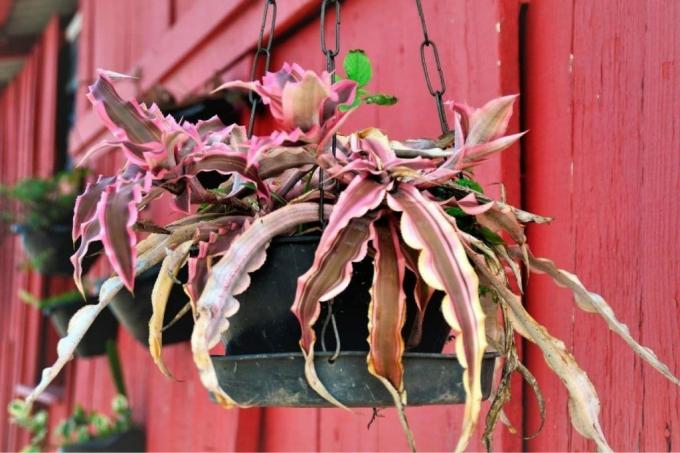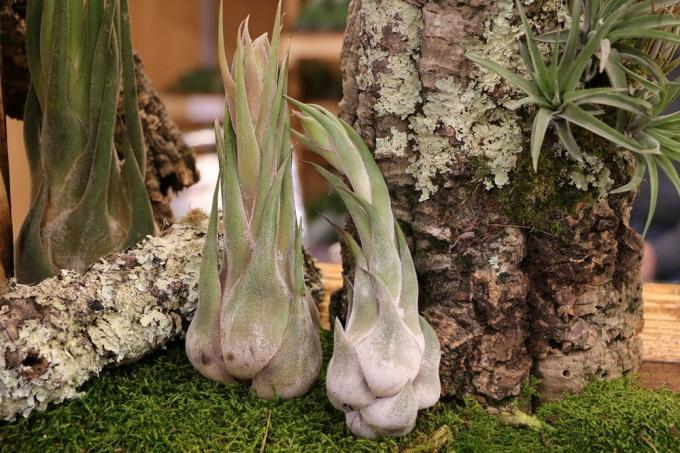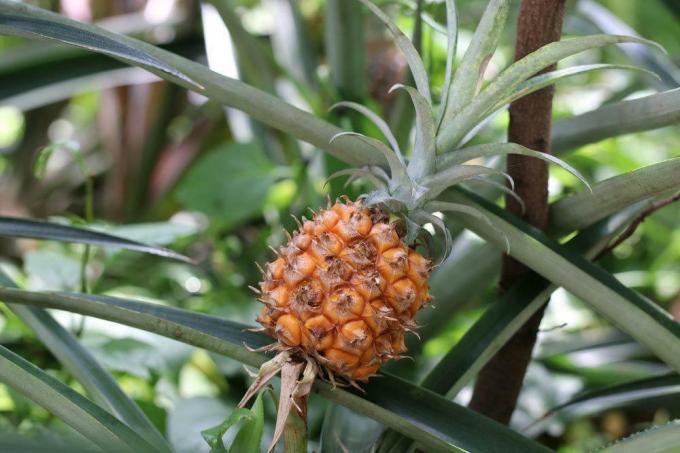
table of contents
- The bromeliad
- Earth star (Cryptanthus), hiding flower, earth bromeliad
- Flaming sword (Vriesea splendens)
- Guzmania (Guzmania)
- Lance rosette (Aechmea)
- Air carnation (Tillandsia)
- Nest rosette (Neoregelia)
- Ornamental pineapple (Ananas comosus), indoor pineapple
- House oats (Billbergia nutans)
- frequently asked Questions
Bromeliads are easy-care houseplants that offer a very varied spectrum. You can find an overview of the most beautiful bromeliads here.
In a nutshell
- all bromeliads are rosette plants
- the best known type is the pineapple
- after flowering, bromeliads die
- Flowers often last for months
- are particularly easy to care for Tillandsia
The bromeliad
All as Houseplants cultivated species of Bromeliad look alike. Especially the lanceolate leaf shape is a distinguishing feature, together with the growth from a leaf rosette. A bromeliad flowers, then usually very conspicuous, with large flowers in strong colors. The flowers often last for months, which takes some comfort from the fact that the plant dies after flowering. Bromeliads prefer different locations. There are tree-dwelling, rock-dwelling or ground-dwelling species.
Note: With all funnel-forming bromeliads, there should always be some water in the funnel. This can also be slightly enriched with fertilizer.
Earth star (Cryptanthus), hiding flower, earth bromeliad
- Origin: bromeliad from Brazil
- Appearance: leaf rosette with lanceolate, wavy and serrated leaves, mostly multi-colored, greenish-white and pink
- Location and substrate: light, warm, but not too sunny and dry, high humidity necessary, loose, permeable, humus-containing substrate
- Watering and fertilizing: keep moist, spray frequently, use water with little lime, use low amounts of fertilizer, every two weeks
- Propagation and repotting: forms Kindel, which can be separated, only repot every four or five years
- Plant protection: no diseases, spider mites if the air is too dry

Flaming sword (Vriesea splendens)
- Homeland: Guyana
- Appearance: leaf rosette with strong leaves, dark green with light green grain, but other colors are also possible, inflorescence like a sword, in bright colors
- Location and substrate: warm, bright, without direct sun, avoid temperature fluctuations, high humidity required, use orchid soil or loose potting soil
- Watering and fertilizing: keep moist, spray frequently, use a small amount of fertilizer, every four weeks
- Propagation and repotting: forms Kindel, repot every three or four years
- Plant protection: no diseases, thrips or spider mites if the location is too dry

Guzmania (Guzmania)
- Home: Bromeliad species from Central and South America
- Appearance: light green leaf rosettes, bracts yellow, orange or red, flowers inconspicuous
- Location and substrate: light, but shady, warm and with high humidity, loose, well-drained substrate
- Watering and fertilizing: keep moist, without waterlogging, fertilize lightly every four weeks
- Propagation and repotting: Kindling, mother plant rather short-lived, therefore repotting unnecessary
- Plant protection: no diseases, spider mites if the air is too dry, scale insects

Lance rosette (Aechmea)
- Home: America
- Appearance: large, lanceolate leaves, patterned light and dark green, inflorescence pink or red, flowers blue
- Location and substrate: warm and bright, without midday sun, coarse, well-drained substrate
- Watering and fertilizing: keep moist, without waterlogging, fertilize lightly every two weeks
- Propagation and repotting: forms kindling or seed propagation, repot every three years
- Plant protection: no diseases, spider mites if the stand is too dry

Air carnation (Tillandsia)
- Home: Bromeliad from South America
- Appearance: Division into green (earth-dwelling) and gray tillandsia (epiphytes, without roots), bracts in bright colors
- Location and substrate: high humidity, gray tillandsias like sunny, tolerate cooler night temperatures, green tillandsia warm and bright, without direct sun, coarse, well-drained substrate
- Watering and fertilizing: spray gray tillandsia daily or dip weekly, keep green tillandsia moist, mix a little orchid fertilizer into the watering or spraying water every month
- Propagation and repotting: Kindling, repot every three years
- Plant protection: Thrips or spider mites if the location is too dry, no diseases

Nest rosette (Neoregelia)
- Home: Brazil
- Appearance: strong green leaf rosette, with reddish colored heart leaves, flowers yellowish
- Location and substrate: bright, also sunny, without midday sun in summer, warm, high humidity, permeable substrate
- Watering and fertilizing: keep moist, fertilize lightly every four weeks
- Propagation and repotting: forms Kindel, repot every three years
- Plant protection: no diseases, spider mites or thrips if the location is too dry

Ornamental pineapple (Ananas comosus), indoor pineapple
- Home: South and Central America
- Appearance: similar to an agave, leaves light and dark green striped, prickly, inflorescence towers above the leaf rosette, reddish in color, fruit is edible
- Location and substrate: warm and bright, without strong sunlight,
- Watering and fertilizing: keep moderately moist, avoid waterlogging, fertilize lightly every two weeks
- Propagation and repotting: forms Kindel, repot every three years
- Plant protection: spider mites in dry air
Note: A houseplant can also be grown from the tuft of leaves of a commercially available pineapple.

House oats (Billbergia nutans)

- Home: Bromeliad species from Central and South America
- Appearance: long, overhanging green leaves, inflorescences red, overhanging and oat-like, flowers greenish-yellow
- Location and substrate: bright, but not sunny, warm, not below 12 degrees in winter, well-drained substrate
- Watering and fertilizing: keep moderately moist, spray from time to time, fertilize every one to two weeks
- Propagation and repotting: forms kindles, which can grow together into dense clusters, every three years
- Plant protection: is considered robust
frequently asked Questions
After flowering, the bromeliad dies and that cannot be prevented. However, most bromeliads already form daughter plants with which they can be propagated.
In summer when temperatures exceed 15 degrees, bromeliads feel good in the garden. It is important that they are brought back into the house as soon as it is cooler.
Since they like high humidity, bromeliads go very well with orchids. They are also suitable for terrariums in combination with other indoor plants.



